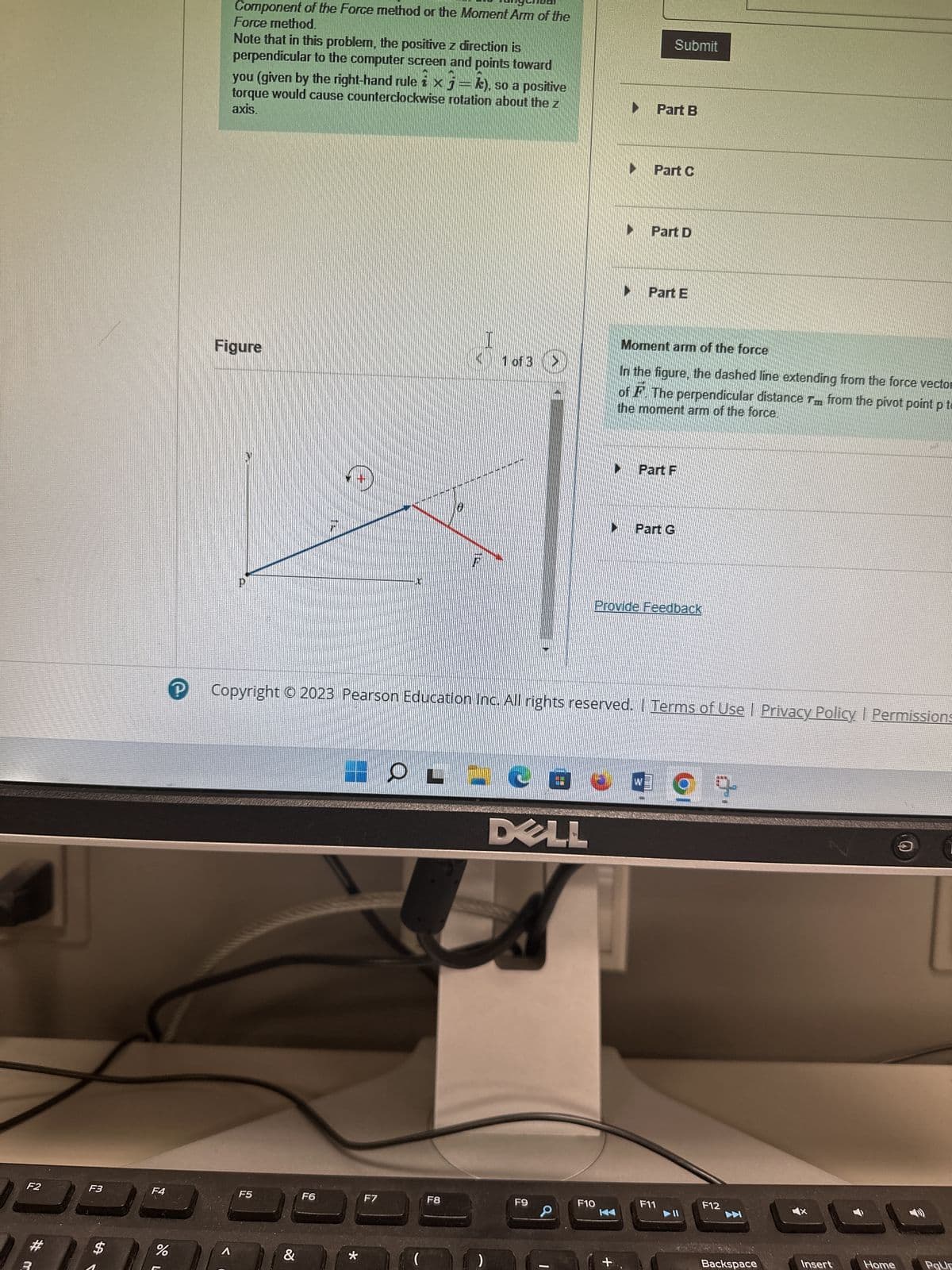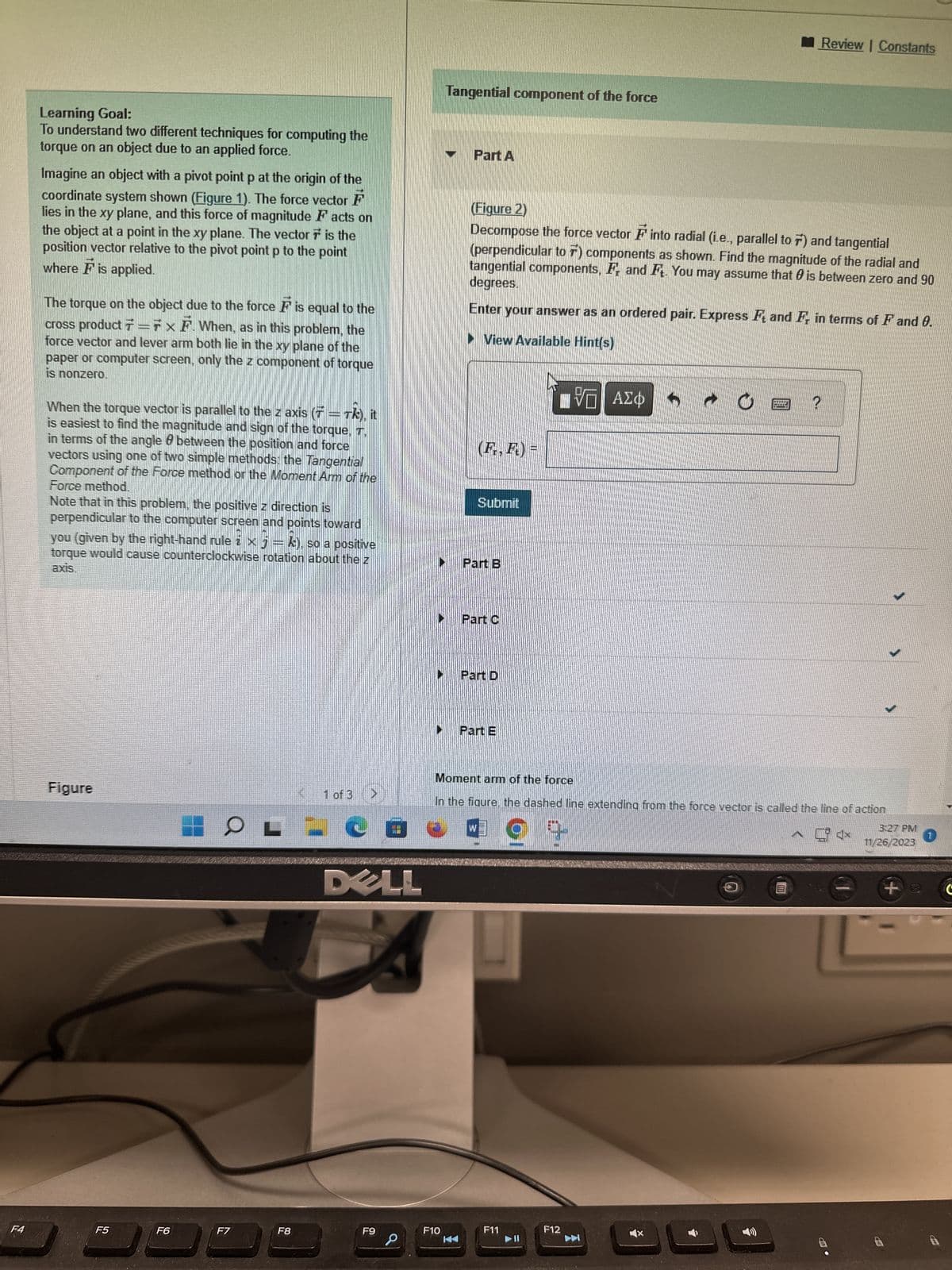Learning Goal: To understand two different techniques for computing the torque on an object due to an applied force. Imagine an object with a pivot point p at the origin of the coordinate system shown (Figure 1). The force vector F lies in the xy plane, and this force of magnitude Facts on the object at a point in the xy plane. The vector 7 is the position vector relative to the pivot point p to the point where F is applied. The torque on the object due to the force F is equal to the cross product 7=7 x F. When, as in this problem, the force vector and lever arm both lie in the xy plane of the paper or computer screen. only the z component of to Tangential component of the force Part A (Figure 2) Decompose the force vector F into radial (i.e., parallel to 7) and tangential (perpendicular to 7) components as shown. Find the magnitude of the radial tangential components, F, and F. You may assume that is between zero degrees. Enter your answer as an ordered pair. Express F and F, in terms of Fa ► View Available Hint(s)
Learning Goal: To understand two different techniques for computing the torque on an object due to an applied force. Imagine an object with a pivot point p at the origin of the coordinate system shown (Figure 1). The force vector F lies in the xy plane, and this force of magnitude Facts on the object at a point in the xy plane. The vector 7 is the position vector relative to the pivot point p to the point where F is applied. The torque on the object due to the force F is equal to the cross product 7=7 x F. When, as in this problem, the force vector and lever arm both lie in the xy plane of the paper or computer screen. only the z component of to Tangential component of the force Part A (Figure 2) Decompose the force vector F into radial (i.e., parallel to 7) and tangential (perpendicular to 7) components as shown. Find the magnitude of the radial tangential components, F, and F. You may assume that is between zero degrees. Enter your answer as an ordered pair. Express F and F, in terms of Fa ► View Available Hint(s)
Related questions
Question
100%
5

Transcribed Image Text:F4
Learning Goal:
To understand two different techniques for computing the
torque on an object due to an applied force.
-
Imagine an object with a pivot point p at the origin of the
coordinate system shown (Figure 1). The force vector F
lies in the xy plane, and this force of magnitude Facts on
the object at a point in the xy plane. The vector is the
position vector relative to the pivot point p to the point
where F is applied.
The torque on the object due to the force F is equal to the
cross product 7=7 x F. When, as in this problem, the
force vector and lever arm both lie in the xy plane of the
paper or computer screen, only the z component of torque
is nonzero.
When the torque vector is parallel to the z axis (7 = Tk), it
is easiest to find the magnitude and sign of the torque, T.
in terms of the angle & between the position and force
vectors using one of two simple methods: the Tangential
Component of the Force method or the Moment Arm of the
Force method.
Note that in this problem, the positive z direction is
perpendicular to the computer screen and points toward
you (given by the right-hand rule i x j = k), so a positive
torque would cause counterclockwise rotation about the z
axis.
Figure
F5
F6
F7
F8
=
1 of 3
DELL
F9
Tangential component of the force
F10
Part A
(Figure 2)
Decompose the force vector F into radial (i.e., parallel to 7) and tangential
(perpendicular to 7) components as shown. Find the magnitude of the radial and
degrees.
tangential components, F and F. You may assume that is between zero and 90
Enter your answer as an ordered pair. Express F and F, in terms of F and 0.
View Available Hint(s)
VE ΑΣΦ
(F., F.) =
Submit
Part B
Part C
Part D
Part E
Moment arm of the force
In the figure, the dashed line extending from the force vector is called the line of action
4x
F11
F12
3
Review | Constants
?
Î
3:27 PM
11/26/2023
+
1

Transcribed Image Text:F4
Learning Goal:
To understand two different techniques for computing the
torque on an object due to an applied force.
-
Imagine an object with a pivot point p at the origin of the
coordinate system shown (Figure 1). The force vector F
lies in the xy plane, and this force of magnitude Facts on
the object at a point in the xy plane. The vector is the
position vector relative to the pivot point p to the point
where F is applied.
The torque on the object due to the force F is equal to the
cross product 7=7 x F. When, as in this problem, the
force vector and lever arm both lie in the xy plane of the
paper or computer screen, only the z component of torque
is nonzero.
When the torque vector is parallel to the z axis (7 = Tk), it
is easiest to find the magnitude and sign of the torque, T.
in terms of the angle & between the position and force
vectors using one of two simple methods: the Tangential
Component of the Force method or the Moment Arm of the
Force method.
Note that in this problem, the positive z direction is
perpendicular to the computer screen and points toward
you (given by the right-hand rule i x j = k), so a positive
torque would cause counterclockwise rotation about the z
axis.
Figure
F5
F6
F7
F8
=
1 of 3
DELL
F9
Tangential component of the force
F10
Part A
(Figure 2)
Decompose the force vector F into radial (i.e., parallel to 7) and tangential
(perpendicular to 7) components as shown. Find the magnitude of the radial and
degrees.
tangential components, F and F. You may assume that is between zero and 90
Enter your answer as an ordered pair. Express F and F, in terms of F and 0.
View Available Hint(s)
VE ΑΣΦ
(F., F.) =
Submit
Part B
Part C
Part D
Part E
Moment arm of the force
In the figure, the dashed line extending from the force vector is called the line of action
4x
F11
F12
3
Review | Constants
?
Î
3:27 PM
11/26/2023
+
1
Expert Solution
This question has been solved!
Explore an expertly crafted, step-by-step solution for a thorough understanding of key concepts.
This is a popular solution!
Trending now
This is a popular solution!
Step by step
Solved in 3 steps with 3 images
